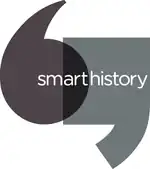Smarthistory
Smarthistory is a free resource for the study of art history created by art historians Beth Harris and Steven Zucker. Smarthistory is an independent not-for-profit organization and the official partner of the Khan Academy for art history.[1][2] It is funded by the National Endowment for the Humanities.[3]
 | |
| Type | Non-profit organization |
|---|---|
| Industry | Education |
| Founded | 2005 |
| Headquarters | New York City |
Key people |
|
| Services | Videos and essays on art and cultural history |
| Website | smarthistory |
History
Smarthistory started in 2005[4] as an audio guide series for use at the Metropolitan Museum of Art,[5] The Museum of Modern Art in New York City,[6] and as a resource for students taking introductory art history courses at the college level.[7] In addition to its focus on college-level courses in art history, Smarthistory supports the art history Advanced Placement course and examination developed by The College Board.[8] Smarthistory provides essays, videos, photographs, and links to additional resources for all of the art and architecture that make up the AP art history curriculum.[9][10]
Smarthistory has published more than 880 videos and 2,000 essays on art and cultural history from the Paleolithic era to the 21st century that include the art of Africa, the Americas, Asia, Europe, and Oceania.[11][12] Smarthistory's essays have been contributed by more than 200 art historians, curators, and archaeologists writing in their areas of focus and are peer-reviewed.[13][11] Videos are unscripted conversations between experts recorded on location in front of the original work of art or architecture.[14][15]
| External video | |
|---|---|
%252C_Rome.jpg.webp) | |
In an article in the Brooklyn New York Daily News, staff writer Elizabeth Lazarowitz quotes Steven Zucker, "Art can be really intimidating for people", said Zucker. "If we can make art feel exciting and interesting and very much relevant to a historical moment...art can have real meaning." Unlike reading about art in a book, "the idea of the audio was to keep a student's eyes on the image", he explained. "It helped students to learn the material a lot better."[16]
Awards & grants
Smarthistory won the Webby Award for Education in 2009.[17] The Samuel H. Kress Foundation gave them a $25,000 grant for development in 2008 and a $38,000 partnership development grant with the Portland Art Museum in 2009.[18]
References
- "About". Smarthistory. Retrieved January 3, 2017.
- Myers, Ken (2013-10-29). "Smarthistory and Khan Academy Bring Art History to Life". Emerging Education Technologies. Retrieved 2023-01-20.
- "Smarthistory: Art, History, Conversation". edsitement.neh.gov. Retrieved 2023-01-20.
- "Smarthistory: No grand strategies needed, just openness". opensource.com. Retrieved 2023-01-25.
- Rivero, Victor (December 16, 2010). "Taking a Close Look at Smarthistory". EdTechDigest. Retrieved January 3, 2017.
- Campbell, Wendy (September 5, 2010). "E-Learning: smARThistory.org". dailyartfixx.com. Retrieved January 3, 2016.
- Harris, Beth; Zucker, Steven (2016). "Making the Absent Present: The Imperative of Teaching Art History". Art History Pedagogy & Practice. 1 (1).
- Doran, Leo (April 22, 2016). "Tech Tools, Image Libraries Transforming Art History Classes". Education Week. 35 (29): 1, 10, 11. Retrieved January 7, 2017.
- "AP Art History Course Home Page". AP Central College Board. Archived from the original on 3 September 2017. Retrieved January 7, 2017.
- Doran, Leo (2016-04-15). "Tech Tools, Image Libraries Transforming Art History Classes". Education Week. ISSN 0277-4232. Retrieved 2023-01-25.
- Smee, Sebastian (1 May 2020). "How two professors transformed the teaching of art history". Washington Post. Archived from the original on 3 May 2020. Retrieved 7 May 2020.
- "Smarthistory: Art History on Khan Academy". Khan Academy. Retrieved January 3, 2017.
- Masson, Patrick (May 2, 2016). "Smarthistory: No grand strategies needed, just openness". Open Source. Red Hat. Retrieved January 7, 2017.
- Colman, Dan (October 1, 2011). "Democratizing Art History: 6 smARThistory Primers". Brain Pickings. Retrieved January 7, 2017.
- "Getty Museum and SmartHistory Collaborate to Make Art More Accessible". getty.edu. Retrieved 2023-02-10.
- "Brooklyn-based art historians launch website with videos of masterpieces". New York Daily News. 2/25/2011.
- "Webby Award Winners 2009"
- "About the partnership with Smarthistory" Archived 2011-03-19 at the Wayback Machine